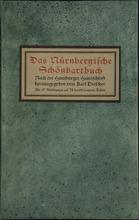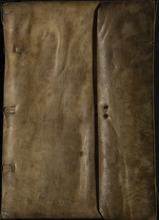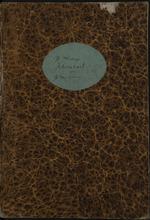1 - 3 of 3 records
Das nürnbergische schönbartbuch nach der Hamburger handschrift herausgegeben

Description: XII + 16 pages, etching by Conrad Waldstromer (* 1178 1266, imperial council, Reichsschultheiß zu Nürnberg) as frontispiece, 97 lithographs on 78 sheets (by HF Jütte), hand-colored by H. Gustav Brinckmann, half-parchment binding from the time approx. 21 × 34 cm (see Figure 5), illustrated inner cover and front pages, cover slightly bumped, one sheet with a backed tear on the side margin (approx. 2 cm), otherwise only minor signs of wear, very nice and firmly bound copy of this rare and richly illustrated editionnnExcerpt from Wikipedia: "The Schembartlauf (to mhd. [Der] schëm (e) shadow, mask", schëmbart bearded mask "folk etymological Schönbart, hence also Schönbartlauf), until 1539 part of the Nuremberg tradition on Carnival, is first documented in 1449. According to legend After a craftsmen's uprising, the Nuremberg butchers were rewarded for their loyalty to the Nuremberg Council with the privilege of holding a Zämertanz on Shrovetide and, among other things, facial to be allowed to wear asks. The original Zämertanz was a performance by the butchers in the tradition of the many artisan dances, in which the dancing men formed a long intertwined chain. Here sausage rings, probably made of leather, were sometimes used as a link from man to man, while other guilds also used swords, hoops or wooden bows with flowers. Probably the Schembartlauf originally arose from the accompanying protective force of the butcher's dance and then became independent. The Schembartläufer, masked and singing shoddy songs, wandered through Nuremberg at Mardi Gras. Their dance was more of a run in which simple hopping figures like figures of eight and mills were formed. The runners were accompanied by men who rode horse dummies. The patrician youth of Nuremberg bought the right to participate (it was probably essentially about the right to mask themselves) from the butchers and thus used the opportunity to present themselves imaginatively. The robes became more and more precious, the Schembartlauf became a great spectacle over the years. In addition to the dance group, individual runners appeared in wild costumes, and from 1475 the Schembart runners pulled a so-called hell "through the Nuremberg streets, a vehicle on sled runners, with the symbolism of which they more and more mocked the social conditions and, in the final phase, the strict Protestant regiment Weimar, Society of Bibliophiles, 1908 (number 96 out of 500 copies), 1908.
Member of: Private Collection of Antiquarian Books and Manuscripts
Resource Type: Text
Schembart book

Description: ii+88 leaves, complete (collation 2+i50, ii20 (16+1+2+1), iii18 (the third gathering is a very complicated quire with four intermediary threads, added leaves and stubs, but it is complete and apparently original in this state, as the first and the last leaf form one bifolio)), 2 flyleaves at front, written on paper of various origins in light brown and black ink by a number of different German cursive hands (one major hand in the first gathering which continues in the second, second hand from ff. 67 (66)-71(70), from f. 72(71) on, four different hands) in one column of varying lengths, modern pencil foliation in upper right, skipping one leaf after f. 17, no ruling, no decoration or other enhancement of script. The watermarks in the first and second gathering mainly from one source (a bear, turned 90°, with collar and tongue poking out, with claws, not recorded in Piccard or Wasserzeichen online database; also a castle or fortress and another bear, none of them identifiable) whereas the watermarks in the third quire are quite mixed: also the bear, but moreover two kinds of coats of arms with crowns, one of them (ff. 86(85)-88(87)) only remotely similar to DE5040-PO-24548 (1648 Speyer), yet so far unidentifiable , however, the two front flyleaves bear the same watermark as ff. 80-82 and 68 and 70, 64 full-figure pen and ink drawings in very fine condition, colored with washes, some details in gold and silver leaf, 22 smaller pen and ink drawings, probably added only slightly later, paper quite strong in varying stages of darkening, thin and thumbed towards the margins, especially in the third gathering, minor stains and spots throughout, some offsets of the washes of the drawings, green hues coloring the ground and some of the costumes often shine through, very few minor tears, no restoration. Contemporary limp vellum binding with flap, loose in binding, lacking fore-edge ties, splits at head and foot of flap fold, inscribed on spine "Schempart Buech."nn"Approximately eighty manuscripts survive as posterior records of the famous carnival parade (Schembartlauf) held on Shrove Tuesday in Nuremberg from 1449 to 1539. Most of the existing manuscripts include marvelous full-page illustrations of participants from the families who, year by year, sponsored the parade, and a few include depictions of the floats. The present remarkable volume in its original binding is not only one of the earliest extant copies but also one of the few to include drawings of the floats. It was customized for its early (and possibly first) owners, the members of the influential patrician family of Kress von Kressenstain in Nuremberg.nn….nn1. Made in Nurmeberg c. 1540-1550, based on the style of the drawings (we are grateful to Fritz Koreny for his expertise). Ex-libris of Iohannes Guilhelmus Kress à Kressenstain dated 1619, an engraved plate with his coat of arms and additional crests of related families (Schweikhart, Haller, Kress, Freidel) glued to front first flyleaf. The Kress family, which in 1530 was permitted to add the title "von Kressenstein" to their name, was one of the major patrician families in Nuremberg. It is quite possible that the present manuscript was made and/or acquired for the Kress family. Members of the family participated in the Schembartlauf (Schembart pageant or carnival) and are recorded here with their masks, names and coats of arms (see below).nn2. Letters "MCP" written in lower corner of f. 1. It is not certain whether this is an ownership entry, which remains to be identified.nn3. Ex libris Liechtensteinianis, engraved armorial bookplate of the princely library glued to front pastedown. Their shelfmark written in pencil on top of first flyleaf: "Ms B. Fach IV", "64 Bl. mit Figuren + 19 Bl. bloss Text," "165.4.8. c. 1561";nn4. In 1949, H. P. Kraus, New York purchased around 20,000 volumes from the Prince of Liechtenstein's library, including this manuscript and other Schembart Books, 1949- 1954;nn5. Paul and Marianne Gourary (1919-2007 and 1920-1914, respectively), New York, Collection of Illustrated Fête Books, their bookplate underneath the Kressenstein label; Christie's New York, Splendid Ceremonies the Paul and Marianne Gourary Collection of Illustrated Fête Books, June 6, 2009, lot 309.",Measurements: 32.5 cm x 22 cm
Member of: Private Collection of Antiquarian Books and Manuscripts
Resource Type: Text
Schembart book

Description: "A substantial attractively illustrated fragment of a Schembart Book, a pictorial representation of Nuremberg's most celebrated public spectacle. The Schembart Lauf was a carnival parade for Shrove Tuesday that originated in 1349 as a privilege granted by the emperor Charles IV to the butcher's guild of Nuremberg. Sometimes riotous (the dancers would run through the streets in extravagant costumes brandishing lances and bunches of leaves that concealed fireworks), the event was banned in 1539. Books recording the carnival's participants and their different costumes from year to year started to be made almost immediately after the Schembart Lauf was banned in an attempt to get the festival restored.nnProvenance: (1) Princely House of Liechtenstein: shelfmark inside upper cover and bookplate on f.1v; purchased from H.P. Kraus in 1955. (2) Paul Gourary (d.2007): his ex-libris, sold at Christie's New York, Splendid Ceremonies, The Paul and Marianne Gourary collection of illustrated Fête books, 12 June 2009, lot 312.",SCHEMBART BOOK, in German, illustrated manuscript on paper [Nuremberg, c.1540]nnbound with LEOPOLD I, Grant of Arms in favour of Johann Christoph Lempen, in German, Schloss Pressburg, 1688.nnA substantial attractively illustrated fragment of a Schembart Book, a pictorial representation of Nuremberg's most celebrated public spectacle. The Schembart Lauf was a carnival parade for Shrove Tuesday that originated in 1349 as a privilege granted by the emperor Charles IV to the butcher's guild of Nuremberg. Sometimes riotous (the dancers would run through the streets in extravagant costumes brandishing lances and bunches of leaves that concealed fireworks), the event was banned in 1539. Books recording the carnival's participants and their different costumes from year to year started to be made almost immediately after the Schembart Lauf was banned in an attempt to get the festival restored.nn305 x 205mm, 36 leaves (of 64), 36 full-page illustrations in colour showing masked and costumed figures, some with carnival floats behind them on the rectos with the descriptive text for the year in a German cursive hand on facing versos, a 20th-century checklist of years pasted inside front cover (corner lacking and hole in shield on f.36, small losses from lower edges of two other leaves, some light staining and spotting, 9 leaves with addition of hearts and/or monograms KSR and CS); 8 leaves with grant of nobility and right to bear arms of Johann Christoph Lempen, written in a cursive German hand and authenticated by public notary Iohannes Philippus Leisner and with his engraved impresa and paper seal on final verso, armorial miniature with Lempen's crested coat of arms between the figures of justice and fortitude, beneath a canopy with the imperial arms and against a seascape. 19th-century marbled paper over pasteboard (joint cracking), brown cloth box with leather lettering-piece.nnProvenance: (1) Princely House of Liechtenstein: shelfmark inside upper cover and bookplate on f.1v; purchased from H.P. Kraus in 1955. (2) Paul Gourary (d.2007): his ex-libris, sold at Christie's New York, Splendid Ceremonies, The Paul and Marianne Gourary collection of illustrated Fête books, 12 June 2009, lot 312.nnFull-page illustrations for the years: 1472, 1475, 1473, 1474, 1476, 1477, 1478, 1479, 1481, 1482, 1484, 1490, 1493, 1495, 1496, 1497, 1498, 1499, 1503, 1504, 1506, 1507, 1508, 1509, 1510, 1511, 1512, 1513, 1514 1515, 1516, 1517, 1520, 1521, 1522 and 1523.
Member of: Private Collection of Antiquarian Books and Manuscripts
Resource Type: Text